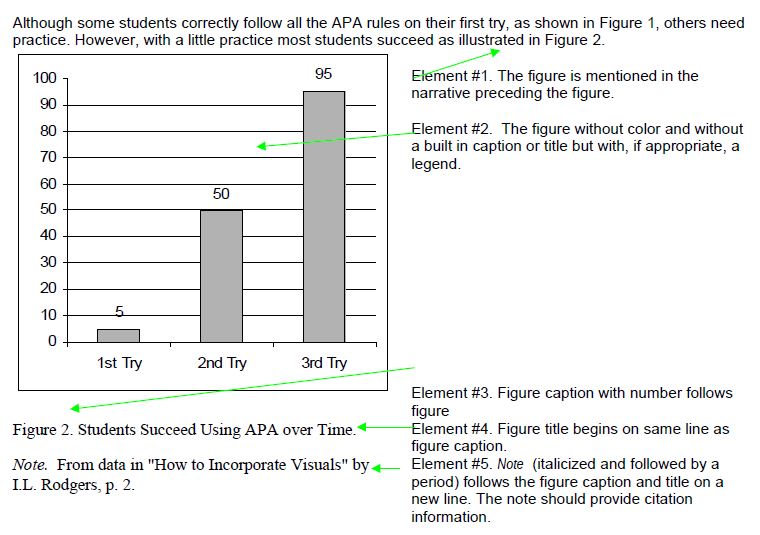INCORPORATING VISUALS
IN APA DOCUMENTS
If you are following APA rules for visuals, this is a short presentation of the rules that must be followed. This information is from the APA's 6th edition.
This information is from the APA's 6th edition.
Types of Visuals
Visual Placement
For manuscripts (academic articles being sent to a publication), place each visual on a separate page at the end of the manuscript. In the text, refer to the visual by its caption and title.
For printed documents with visuals small enough to be included in the text, introduce the visual in the text and refer to it by its caption.
The Basic Elements for Visuals
Table and figure visuals include the following five elements:
Tables follow these formatting rules:
Your first step is to introduce your visual in your body text, and that introduction must include the caption. Your narrative highlights important information shown on the visual, but do not relate all your data in your narrative. Just introduce your visual, and put your visual on the same page as the introduction.
Notice the following facts in the illustration of a table in Figure 1:
This information is from the APA's 6th edition.
Types of Visuals
- Tables
- figures
- equations
Visual Placement
For manuscripts (academic articles being sent to a publication), place each visual on a separate page at the end of the manuscript. In the text, refer to the visual by its caption and title.
For printed documents with visuals small enough to be included in the text, introduce the visual in the text and refer to it by its caption.
The Basic Elements for Visuals
Table and figure visuals include the following five elements:
- (If the visuals goes in the text) Introduction of the visual in the text including reference to the visual by its caption (i.e. Table 2 or Figure 4)
- The visual's caption: Table # Figure # Equation #
- The visual's title (italics for tables, not italics for figures; upper and lower case lettering)
- The visual
- The note: Note (italicized and followed by a period) follows the table or follows the figure caption and title and may be "general notes, specific notes, and probability notes" (3.70, p. 170). For reports displaying data from resources, the notes should explain where the data was obtained. Notes also serve as a place to include a copyright notice for original work.
Tables follow these formatting rules:
- Caption placement: top of table
- Table caption (number) first line, normal font
- Table title in normal italics font on second line
- Headers and sub-headers as appropriate
- Data presented in columns and rows
- Use of horizontal lines at the top, bottom, and dividing sections, but no vertical lines and no colors or shading
- Note (in italics and followed by a period) follows the table to provide source information
Your first step is to introduce your visual in your body text, and that introduction must include the caption. Your narrative highlights important information shown on the visual, but do not relate all your data in your narrative. Just introduce your visual, and put your visual on the same page as the introduction.
Notice the following facts in the illustration of a table in Figure 1:
- Five elements
- Lines and absence of lines (vertical top & bottom of header row and at the bottom of the table)
- Absence of color and shading
- The caption goes above the table (remember this: Table Top!)
- The Note is followed by a period.
Figure 1 Screenshot of a Labeled APA Table.
Note.
Note.

Labeled Figure of an APA Table by Ida L. Rodgers, Ph.D. is licensed under a Creative Commons Attribution-NonCommercial 3.0 Unported License
Special Features of Figures
Figures follow these formatting rules:
Your first step is to introduce your visual in your body text, and that introduction must include the caption. Your narrative highlights important information shown on the visual, but do not relate all your data in your narrative. Just introduce your visual, and put your visual on the same page as the introduction.
Notice the following facts in the illustration of a figure in Figure2:
Figures follow these formatting rules:
- Caption placement: bottom of figure
- Figure caption (number) and title (not italics) are on the same line
- Note (in italics and followed by a period) follows the figure caption and title to provide source information
Your first step is to introduce your visual in your body text, and that introduction must include the caption. Your narrative highlights important information shown on the visual, but do not relate all your data in your narrative. Just introduce your visual, and put your visual on the same page as the introduction.
Notice the following facts in the illustration of a figure in Figure2:
- Five elements
- Absence of color
- The caption goes below the figure (remember this: Table Top! so Figure Bottom!)
- The Note is followed by a period
Figure 2. Screenshot of a Labeled APA Figure.
Note.
Note.

Labeled Figure of an APA Figure by Ida L. Rodgers, Ph.D. is licensed under a Creative Commons Attribution-NonCommercial 3.0 Unported License.

